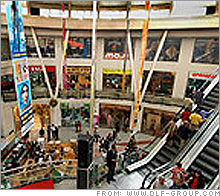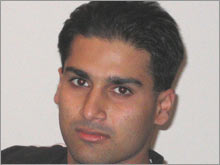Be Indian, buy AmericanWal-Mart and Starbucks are among the iconic American brands itching to sell in India. But which brands do young, cash-rich Indian shoppers really want?NEW YORK (CNNMoney.com) -- India's young, cash-rich shoppers have already picked out a few of their favorite American brands. Who do they like? Gap (Charts, Fortune 500), Harley-Davidson, J.C. Penney (Charts, Fortune 500), OfficeMax and Disneyland.
It's quite an eclectic list, and it doesn't end there. But none of those brands currently have a presence in India's $300 billion consumer market. So what's creating the thirst for these retailers and brands? "In most middle-class Indian households today, there's typically a cousin or another family member that's been to the U.S. and they come back and describe these stores," said Love Goel, CEO of Growth Ventures Group, a global private equity firm that's focused on investment in the Indian retail sector. Moreover, with high cable television penetration rates, especially among the 200 million-plus middle-class households, Goel said many more Indians are closely watching the brands worn by both American and Indian celebrities and entertainers on networks like MTV or VH1. "There's a cultural phenomenon in India that is quite pervasive," Goel said. He described it as "foreign envy." If you own something that's from abroad, it sets you apart from your peers. U.S. retailers have taken note and are more keen than ever to get into the country, for two main reasons. First, many American brands and store chains have saturated their home market and are finding it increasingly difficult to squeeze out more sales and profits in the United States. So they're scouting for more lucrative selling opportunities overseas. India's rapid growth as a consumer economy, led by an expanding middle and upper-middle class population that loves to shop, makes it more attractive every day. A 2006 McKinsey report on the Indian consumer market suggest that India's consumer goods market could reach $400 billion by 2010, making it one of the five largest in the world after the United States, Japan, China and Germany. "Add the fact that during the next few decades India will likely surpass China as the world's most populous country and it is clear that the multinational consumer goods companies seeking faster growth must begin to focus on the subcontinent," the report said. Secondly, India, which until recently had very strict rules governing the entry of foreign retailers, has relaxed some of those regulations. The most significant policy change took place last year when the Indian government announced it would allow "single-brand" retailers such as Nike or Gucci to own 51 percent of their business operations in India. That opened the door for Starbucks (Charts, Fortune 500), which reportedly has entered into a partnership with an Indian retail entity to open a chain of locations in India, although the deal is still pending government approval. However, the retailing rules in India still preclude entry to merchants like Wal-Mart (Charts, Fortune 500) or J.C. Penney that sell a variety of brands. So Wal-Mart, eager to have some kind of foothold in India, entered into a joint venture with Bharti Enterprises to provide back-end support for a chain of discount stores that will be 100-percent owned and operated by Bharti. Goel thinks the discount format will do well in India. "Even though the middle class, which has the discretionary income to spend, is becoming wealthier, they still like to save 40 to 50 percent of their income," he said. Sushant, 22, an export manager with New Delhi-based Sakshay International who earns about 35,000 Rupees ($750) a month, agreed with Goel. "Wal-Mart is good for India. It will trigger price wars and intense competition. Ultimately the consumer will benefit because as you know, India is a very price-sensitive economy," he said. Aditya Moda, 22, a business manager with Bhartia Vehicles & Engineering Co. Ltd. in New Delhi, welcomed Wal-Mart's presence in India for another reason. "It's a clear sign of true globalization that the world's biggest retail chain is coming to India," Moda said. "Wal-Mart is already in India as it is sourcing huge amounts of raw material from here. Now it will be selling in India which will create a new shopping culture for us," said Moda, referring to a retail landscape that's 97 percent represented by mom-and-pop businesses. However, Gaurav Sharma, 23, an MBA student from Noida in the Indian state of Uttar Pradesh, said he opposed Wal-Mart coming to India because he feared "it would be a grave threat for the small Indian retailers." Lots of interest in Gap and Old Navy Vinod Nair, fashion group editor for leading national English-language newspaper Hindustan Times, told CNNMoney.com that India represents a very lucrative market for mid-priced fashion brands like Gap and Old Navy. "As you know, many of the top luxury brands like Lacoste, Louis Vuitton, Hermes are already here because more Indians can afford them," Nair said. "But the market is still wide open for a mid-market brands. CK by Calvin Klein, Banana Republic, Old Navy can create a huge niche here since they already do so much of their manufacturing here." And they better get in soon, since many of these brands' European counterparts have figured out what Nair was talking about. Moderate-priced Spanish chain Mango has already opened five locations in India. Sanjeev, 31, a senior executive with India-based shipping company Shobit International, said he wishes Gap and Penney would come to India. "I like the prices you find in those stores and that quality of merchandise does not exist here yet," he said. Besides shopping, young Indians also need more places to hang out. Traditionally, kids would hang out at each other's homes. But that is changing thanks to the proliferation of multiplexes in major cities like Delhi and Bombay as well as malls and Starbucks-like coffee houses called Barista and Coffee Day. Said Nair, "I think both Starbucks and Dunkin' Donuts would be ideal for India because they're small format and not too expensive." Maninder Bola, 25, said he's voting for Panera Bread as well. "I love Starbucks coffee and Panera Bread food," Bola said. "Both chains have big potential in the Indian upper middle class segment who will be willing to pay a premium." Bola, who's from New Delhi, came to America in 2004 as a graduate student and currently works as a consultant based in the United States. His other retail pick for India is office supply chain OfficeMax. "When it comes to home and office needs, India is a very fragmented market, which means I would not get everything from one retailer," Bola said. "It's simply about convenience of shopping in one store plus superior customer service." |
| ||||||||||||




